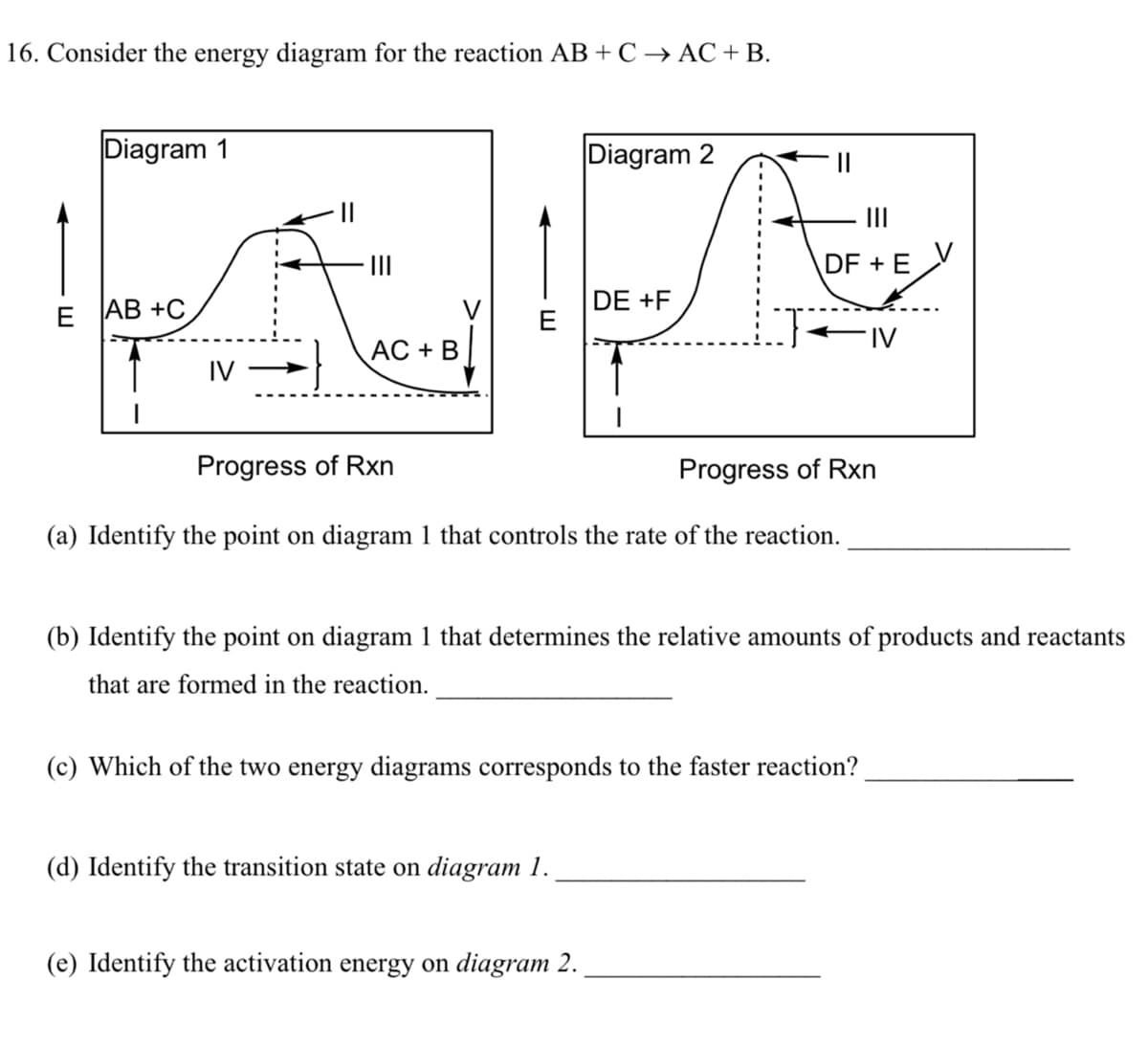16. Consider the energy diagram for the reaction AB + C → AC +B. Diagram 1 Diagram 2 II DF + E Е АВ +C DE +F E АC + B IV Progress of Rxn Progress of Rxn (a) Identify the point on diagram 1 that controls the rate of the reaction. (b) Identify the point on diagram 1 that determines the relative amounts of products and reactants that are formed in the reaction. (c) Which of the two energy diagrams corresponds to the faster reaction? (d) Identify the transition state on diagram 1. (e) Identify the activation energy on diagram 2.
16. Consider the energy diagram for the reaction AB + C → AC +B. Diagram 1 Diagram 2 II DF + E Е АВ +C DE +F E АC + B IV Progress of Rxn Progress of Rxn (a) Identify the point on diagram 1 that controls the rate of the reaction. (b) Identify the point on diagram 1 that determines the relative amounts of products and reactants that are formed in the reaction. (c) Which of the two energy diagrams corresponds to the faster reaction? (d) Identify the transition state on diagram 1. (e) Identify the activation energy on diagram 2.
Introduction to General, Organic and Biochemistry
11th Edition
ISBN:9781285869759
Author:Frederick A. Bettelheim, William H. Brown, Mary K. Campbell, Shawn O. Farrell, Omar Torres
Publisher:Frederick A. Bettelheim, William H. Brown, Mary K. Campbell, Shawn O. Farrell, Omar Torres
Chapter7: Reaction Rates And Chemical Equilibrium
Section: Chapter Questions
Problem 7.59P
Related questions
Question
Consider the energy diagram

Transcribed Image Text:16. Consider the energy diagram for the reaction AB + C → AC +B.
Diagram 1
Diagram 2
II
II
DF + E
Е АВ +C
DE +F
E
FIV
АC + В
IV
Progress of Rxn
Progress of Rxn
(a) Identify the point on diagram 1 that controls the rate of the reaction.
(b) Identify the point on diagram 1 that determines the relative amounts of products and reactants
that are formed in the reaction.
(c) Which of the two energy diagrams corresponds to the faster reaction?
(d) Identify the transition state on diagram 1.
(e) Identify the activation energy on diagram 2.
Expert Solution
This question has been solved!
Explore an expertly crafted, step-by-step solution for a thorough understanding of key concepts.
This is a popular solution!
Trending now
This is a popular solution!
Step by step
Solved in 2 steps

Recommended textbooks for you

Introduction to General, Organic and Biochemistry
Chemistry
ISBN:
9781285869759
Author:
Frederick A. Bettelheim, William H. Brown, Mary K. Campbell, Shawn O. Farrell, Omar Torres
Publisher:
Cengage Learning

Chemistry: Principles and Reactions
Chemistry
ISBN:
9781305079373
Author:
William L. Masterton, Cecile N. Hurley
Publisher:
Cengage Learning

Introductory Chemistry: A Foundation
Chemistry
ISBN:
9781337399425
Author:
Steven S. Zumdahl, Donald J. DeCoste
Publisher:
Cengage Learning

Introduction to General, Organic and Biochemistry
Chemistry
ISBN:
9781285869759
Author:
Frederick A. Bettelheim, William H. Brown, Mary K. Campbell, Shawn O. Farrell, Omar Torres
Publisher:
Cengage Learning

Chemistry: Principles and Reactions
Chemistry
ISBN:
9781305079373
Author:
William L. Masterton, Cecile N. Hurley
Publisher:
Cengage Learning

Introductory Chemistry: A Foundation
Chemistry
ISBN:
9781337399425
Author:
Steven S. Zumdahl, Donald J. DeCoste
Publisher:
Cengage Learning

Chemistry: The Molecular Science
Chemistry
ISBN:
9781285199047
Author:
John W. Moore, Conrad L. Stanitski
Publisher:
Cengage Learning

Chemistry for Engineering Students
Chemistry
ISBN:
9781337398909
Author:
Lawrence S. Brown, Tom Holme
Publisher:
Cengage Learning

Chemistry: Principles and Practice
Chemistry
ISBN:
9780534420123
Author:
Daniel L. Reger, Scott R. Goode, David W. Ball, Edward Mercer
Publisher:
Cengage Learning